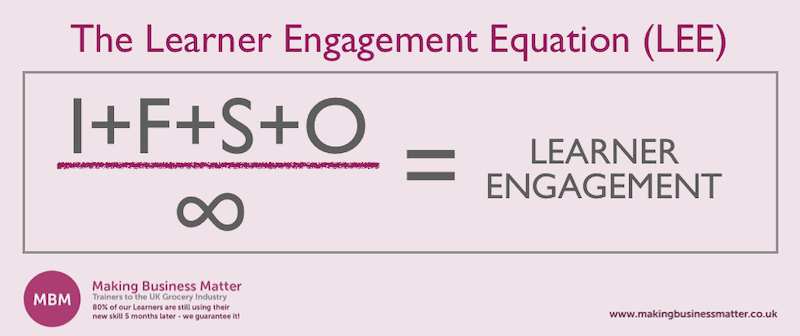Improve Training Results With the Learner Engagement Equation
Anyone in Human Resources can tell you that employee training is hard. New hires are enthusiastic and willing to learn, but the shine soon wears off and they start to see training days as ‘going off on a jolly’ rather than a chance to boost company results by improving their skills. The most recent crop of employees – millennials – can prove particularly difficult to engage, due to a quantum shift in underlying values and job expectations.
Thankfully, so much has been written about course design and training engagement that there are simple, actionable ideas that work across a broad spectrum of industries. The Learner Engagement Equation (LEE) is one such idea.
The Learner Engagement Equation is a simple way of analysing your company’s training offering to optimise worker engagement.
It’s a fraction, ‘IFSO divided by infinity’. Used effectively in combination with an expert trainer’s presentation skills, the Learner Engagement Equation encourages learners to absorb new skills and keep them for the long term.
Let’s break down the equation:

‘I’ Stands for Me, the Self
Your employees want to know what they are getting out of any training course. And that means what they get for themselves, not just for the company.
Sticky Learning ® is 7 times more effective than 1-day training courses. Plus, you will get a Chain of Evidence proving your Return on Investment. Discover soft skills training that changes behaviours long term.

‘F’ Is First Impression
Learners frequently believe that training, learning and education are pointless. Many think it adds no value to their existence and is merely a tool the company uses to squeeze more productivity out of them for the same salary. They look for first impressions that cement this premise. A good first impression is, therefore, an essential part of the Learner Engagement Equation.
‘S’ Stands for Support
As people managers or leaders, you must fully and enthusiastically support training offerings. Your team members – even the most uninspired, stubborn and negative team members – are influenced by your attitude. One misplaced negative comment from you can cause an employee to tune out of training completely.

‘O’ Is for Opportunity
You must tailor your learning program to offer maximum benefit to attendees. It must be relevant to their work and they must see evidence of immediate opportunities to apply the acquired skills to achieve more – for the company and for themselves. Employees take training more seriously when they see an immediate, concrete benefit.
The acronym across the top of the equation reads ‘IF SO’, and that’s deliberate. These four fundamentals must all be present for success. If so, learner engagement will skyrocket; if not, learners will likely relapse into their old, negative mindset. One missing or faulty element taints the whole process and can result in failure.
The Bottom Line of the Learner Engagement Equation Is ‘Infinity’
The infinity symbol represents the never-ending list of problems you must handle. Anyone who’s ever planned or executed training is familiar with the phenomenal number of potential problems, all of which combine to reinforce a negative attitude towards learning.
The infinity sign represents everything that can go wrong, including (but not limited to):
- Late arrivals
- Boring handouts
- Inappropriate venue
- Number of breaks in the course
- Workload
- Trainer ability
- Previous training (and school) experience
- Interruptions and flow
‘Infinity’ can easily overwhelm the four IFSO elements – it’s infinite for a reason – making the whole training process pointless. The best you can do is to get as many factors as possible right, but, above all, make sure you don’t get any horribly wrong!
The Learner Engagement Equation helps you deliver training that employees actually grasp and hold onto, rather than turning up on the day and ‘just getting it done.’ It’s a superb tool because you can use it both before and after delivery. It’s both a great framework for planning your training offerings to maximise learner engagement and ideal for post-mortem analysis, to see where you’re getting it right or wrong.
Learn More About the Learner Engagement Equation
There are many ways to find out more about the Learner Engagement Equation (LEE), from calling in an expert to train your trainers to excellent online resources that outline approach and delivery.




